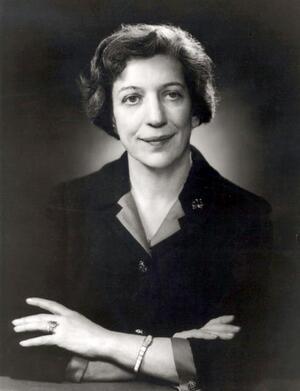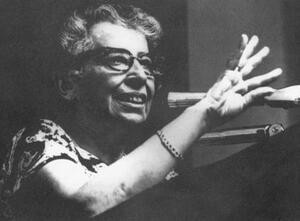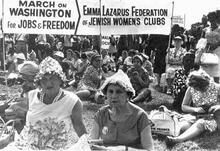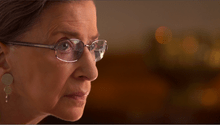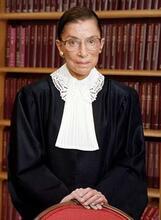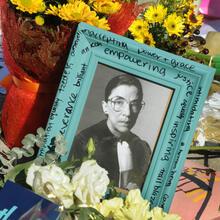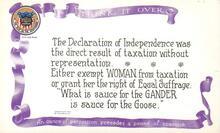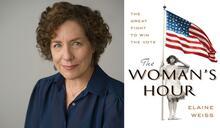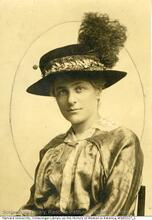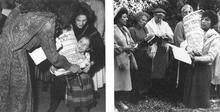Law in the United States
A fighter throughout her life for the rights of children and minorities, Justine Wise Polier was a judge of the New York City Family Court for thirty-eight years. She attributed her main goals of fighting injustice and "speaking truly… without fear" to the influence of the Hebrew prophets and her father, Rabbi Stephen Wise.
Institution: American Jewish Historical Society
Until recently, “law” in relation to the Jewish community meant religious law, while external governmental law was seen as something only to be accommodated as part of the historical situation. However, in a “post-emancipation” context, the word “law” is related to official behavior, enforcing equal treatment of groups regardless of religious background or ethnicity. For Jewish women who immigrated to the United States, this modern approach afforded them new freedoms, especially under secular as opposed to religious leadership. This article juxtaposes the idea of “law” with the idea of “Jewish women in America” by exploring three subjects: the interaction of legal systems; the impact on women of particular changes in the substance of law(s); and contributions to law of individual women.
Introduction
The situation of the Jewish community in the United States is shaped fundamentally by the condition of political equality. This legal status is shared with all other citizens and is assumed as an essential baseline. Where there are violations of that status—when an individual otherwise of full legal capacity is treated as a member of a subordinated racial or religious group, and when group membership defines rights and duties—we discuss the problem under the heading “discrimination.”
In Jewish history, political equality has a specific historical dimension. It is a “post-emancipation” phenomenon. Count Clermont-Tonnerre’s famous words are descriptive: “To the Jews as a people, nothing; to the Jews as citizens, everything.” In this modern view, the word “law” itself is related to official behavior. Emancipation assumes that, in relation to the state, members of groups are in general treated equally, regardless of religious background or ethnicity. In such a context, “law” means secular law, the law of the state regulating the status of subjects and citizens. Any other law—religious law or folk law—is considered not really law at all.
We would have a very different picture if we were describing the idea of law in other times and places. The index to Life Is with People, a well-known book on the (Yiddish) Small-town Jewish community in Eastern Europe.shtetl, has an entry that makes the point: “law, see Torah she-bi-khetav: Lit. "the written Torah." The Bible; the Pentateuch; Tanakh (the Pentateuch, Prophets and Hagiographia)Torah.” Until recently, “law” in relation to the Jewish community meant religious law. The existence of external governmental law was acknowledged, of course, but that external law was seen largely as something to be accommodated, an aspect of the historical situation. This is reflected in the maxim Dina de-malkhuta dina: the law of the kingdom is law.
For the women who came as immigrants to the United States, the American approach—built on ideas from the eighteenth-century Enlightenment and nineteenth-century liberalism—often was a new situation. They had come from countries in which religious law was the defining law of their communities, under the system of state law. In such systems of state regulation, certain authority was delegated to the religious leadership. Religious law was, in effect, recognized by the state as the law of an internally regulated autonomous community that operated its own system of sanctions. Both such delegation to religious law and the customs of the Jewish community restricted the roles of women.
This article juxtaposes the idea of “law” with the idea of “Jewish women in America.” The result of this juxtaposition is a brief inquiry into three separate subjects: the interaction of legal systems; the impact on women of particular changes in the substance of the law(s); and the contributions to law of individual women.
The Law of the Nation and the Law of the Group
The Old Testament describes an ideal of law, and of church and state, in which religious and secular law are fused in a religious commonwealth. Long after the dispersion of the Jews, the theocracies of ancient Israel provided a model of such a government for the Western world. The early colonists in North America, for example, attempted to establish a city upon a hill, modeled (particularly in Massachusetts and Connecticut) on the commonwealth of ancient Israel described in the Old Testament.
Law and government in the West were not, however, typically theocratic even in those centuries characterized by the unity of Christendom. Law emanated from a multiplicity of sovereignties, some associated with kings and public officials, others with popes and clerics, still others with smaller units of society operating as self-regulatory bodies. In the medieval situation of pluralist law, any particular religious community’s law was one body of law competing with others. The modern state had not yet so clearly triumphed that its law was given the name “Law.”
We often assume today that the triumph of the secular government is complete. We talk as though religious authority has been eliminated and state power is all that remains. Yet we might more accurately say that the decline of religious authority is a decline in the public coercive aspects of religious regulation, but that religious authority, in the lives of an observant religious community, is still powerful. Today it operates in what is called the “private” sector, generally as a matter of individual submission to the will of the religious community and its sanctions.
In the modern American situation, secular law and religious law are still interdependent and interacting legal systems. In one model interaction, a rough substantive correspondence is assumed between the law of a religious system and the law of the state. The state considers itself, in more or less structured ways, for example, to be a “Christian Nation” in a world of Christian denominations, with smaller or larger non-Christian communities tolerated by the state. This generally was the situation in what is loosely termed Christendom, and it was equally the situation in the Ottoman Empire. In some contexts, both historically and today, this system involves a kind of official delegation of authority to religious leaders of minority traditions to administer their own law under the auspices of—and within limits set by—the majority system. Appeal to the state from the community was possible. Thus the nineteenth-century feminist Ernestine Rose successfully fought her father, a Polish rabbi, in the Polish civil courts. But such appeals to the state were rare.
A comparison between the situation of a Jewish and a Catholic immigrant to the United States in the late nineteenth century is useful on this point. When newcomers arrived in the United States, they found a law of marriage and divorce that assumed complete state authority. Following Christian approaches, state law restricted divorce (though it was becoming increasingly available), insisted on monogamy, and prohibited incestuous marriages. The illegality of birth control was assumed by the state system—following the Catholic position—until the mid-twentieth century. Jewish law was more open on the issue of contraception—and on divorce—though its availability in practice was restricted in part because of the rules of the surrounding state systems. Other family law issues (relating, for example, to religious matching in the context of adoption) had an impact on both groups.
Problems under the law were different for the two immigrant groups. For Catholics, the possibility of divorce in the secular culture raised the question of whether to divorce and remarry in the outside system without the blessing of the church. (The church typically insisted that the first marriage, unless annulled by the church, remained valid.) For Jews, the question might result in confusion on the issue of which official—religious or secular—had authority to issue a divorce, because both systems recognized divorce and remarriage. Rabbinic authority in the country of origin was sometimes sufficient to effect such a change in legal status. In the United States, it was not. The risk was that mistaken reliance on a religious divorce would result in a bigamous second marriage. This was an issue well into the twentieth century. It was a matter of concern, for example, for the New York City Kehilla—the attempt by Jews in New York to form a modern version of the traditional, quasi-autonomous Polish Jewish community.
Some aspects of tension between rabbinic and secular authority are still visible today. Among the most difficult problems arise in the context of family law. A prime example is the get, the Jewish divorce, which must, according to tradition, be issued by the husband to the wife. Because religious sanctions are no longer sufficiently powerful in all cases to pressure a recalcitrant husband to give a get, the Woman who cannot remarry, either because her husband cannot or will not give her a divorce (get) or because, in his absence, it is unknown whether he is still alive.agunah [chained wife] has sought state intervention to pressure husbands to give divorces. Some have focused on state solutions (e.g., the New York get law) to this problem, while others have worked on finding solutions within the religious tradition (e.g., the possible use of conditional divorce).
It may be that, indirectly, ideas of egalitarianism and emancipation have had an impact on religious tradition and modern understandings of its rules. The division of religious authority in the United States makes a variety of religious options available for individuals. Difficulties are most acute for those who want not only to remain within traditional religious structures but also to absorb the egalitarian values of the modern state into their own lives. (Still, it may be noted that the situation is less difficult in the United States than in Israel, where traditional religious authority is given governmental power.)
Emancipation operates to free individuals from the restraints of groups. In modern conceptions of religious liberty, religious group membership is voluntary, at least as understood by the state. Exit from a group is a serious possibility, because, in effect, emancipation simultaneously opened both the doors of the larger society and the doors of the community. A situation in which everyone has to be a member of some community, and exit from one either involves membership in another (conversion) or some sort of outlaw status, is quite different from a situation in which state citizenship is a residual category for everyone and group membership is viewed as a private associative option. Emancipation and assimilation produce exits from communities as well as changes in those communities. It may be noted on this point that groups themselves often adopt different definitions of affiliation. For some groups exit is impossible, at least from the point of view of the group. The state’s answer to that question, where it becomes relevant, is often different depending on the legal system of the country in which the question is raised. In some legal systems, (e.g., the United States), the issue turns almost entirely on an idea of voluntary association or personal affiliation and commitment. In others, the matter is decided on the basis of formal religious or racial definitions. Group sanctions continue to exist, but some, such as expulsion and excommunication, operate most effectively on those most strongly identified with traditional structures. Thus the claim of the group to a permanent and irrevocable affiliation is one that in the modern situation can be simply denied by an individual who chooses to reject the group and, in effect, move away into the larger society. The more open the social and practical situation, the more real the possibility of exit.
The Impact of State Law on Jewish Women
We can speak of the impact of state law on Jewish women in the United States across a time frame of several hundred years, from the time that the first group came to New Amsterdam in 1654. And we can note here that one form of religious freedom could involve recognition of group authority. (See the Rhode Island statute authorizing the uncle-niece marriage of Jewish law as an exception to the state incest law dating from 1798.)
Yet the early experience must be viewed against two other points. First, we must note the diversity and strength of later Jewish immigration. Most of the Jewish women affected by changes in the law were not the descendants of those original settlers. Rather, the Jewish population was regularly enlarged and changed by waves of immigrants arriving over the next two centuries. Some came from situations in which emancipation had been in place for a century, others from contexts built on the conception of a separate, autonomous Jewish community. If Hannah Arendt can represent women of the twentieth-century German refugee tradition, the tradition of the shtetl might be represented by some women of Eastern European communities. The class background of Jewish immigrants generally ranges from those like the Brandeis family (described by Josephine Goldmark), who arrived in the mid-nineteenth century with a grand piano or two, to those who came later in steerage with virtually nothing. Immigrants came (and come) from Eastern Europe and from the Middle East, from backgrounds more or less affluent, Westernized, observant.
Second, the legal context changed substantially with the disestablishment of the Christian churches, a process formalized at the national level through the First Amendment to the Constitution. At the state level, the process was not concluded until 1833, when Massachusetts disestablished its church. Under the theories of separation of church and state formulated in the First Amendment (“Congress shall make no law respecting an establishment of religion, or prohibiting the free exercise thereof”), the state could not act directly against any protected “exercises of religion.” The state thus cannot insist, for example, on the ordination of women or the revision of the liturgy.
The diversity of the social and economic situations of Jewish immigrants meant that the particular attributes they brought to the United States were very different. Yet the openness of the American situation had an impact on all of them. The change in the legal status of women in the first part of the twentieth century, for example, relating to suffrage and jury service, touched all women. Attempts to discriminate against women came to be rooted less in law than in social role definitions, which made it difficult if not impossible for women both to maintain public or market positions and to raise families, despite the formal equality marked by full political rights. General societal concern with violence against women also reached the Jewish community.
It is also true, however, that the traditional rules of the Jewish community continued to exclude women from full participation in the synagogue service and from ordination as rabbis and insisted on separate seating in houses of worship. The assumption that a woman’s primary role was as a mother and a supporter of the family—a carrier of cultural values but not religious values institutionally understood—remained unchanged in the less assimilated parts of the community.
But it should also be noted that while women were subordinated in the Jewish tradition, they were in other ways not dependent. In Eastern Europe, for example, it was entirely conventional to say that it was an honor for a wife to support her scholar husband. (The scholarship was assumed to be a religious scholarship.) To the extent that women were understood to be responsible for the support of their families by working in the family business (but not for strangers), we see a pattern quite different from the subordination and economic and psychological dependency often associated with the idea of the “separate spheres.” The managerial skill, shrewdness, and competence that parts of traditional Jewish culture allowed women made possible a transition to the modern commercial and professional world for Jewish women that was presumably more difficult for women socialized in more stereotypically male-dominated cultures.
Participation of Women in Law
As general societal discrimination against women in the professions weakened, women entered the professions for reasons somewhat similar to those that influenced men. To begin with, law has a very special place in America. It is at the center of the culture, a road to middle-class success and status. It is, simultaneously, a way to seek reform and social change, a path for those pursuing justice in the prophetic tradition. Jerold Auerbach suggests that law had a highly particularized role in the minds of the Jewish immigrants to the United States. For many, commitment to American legal forms and American democratic faith replaced the traditional faith. This observation may well hold across genders.
Having said this, however, we should consider the specific contribution of Jewish women to law.
Women lawyers would be a useful addition to the list—largely if not entirely male—offered in the Encyclopedia Judaica. In Women in Law, Cynthia Epstein describes the careers of Nanette Dembitz Brandeis and Justine Wise Polier, daughter of the Rabbi Stephen Wise. (Both were judges in New York.) Of course, in addition to Justice Elana Kagan and the late Justice Ruth Bader Ginsburg on the Supreme Court, there are now Jewish women who serve as state court judges.
The contribution of women to law need not, however, be limited to those who practice law (with or without their husbands) or become judges. Contributions to law might well be looked at more broadly. To illustrate with a familiar example, the famous Brandeis brief, which brought social science material to the attention of the Supreme Court in Muller v. Oregon (208 US 412 (1908), upholding the Oregon statute regulating hours of employment for women), was the work of Brandeis’s sister-in-law, Josephine Goldmark. She was not a lawyer, but her contribution to the law is plain. We also might look for Jewish women who have been plaintiffs in lawsuits, particularly lawsuits understood as test cases involving significant public propositions. Esta Gluck, president of a parent-teachers association, and active in the American Jewish Congress, for example, was a plaintiff in Zorach v. Clauson (343 US 306 (1952), upholding the New York released-time program). More broadly, it would be appropriate to see the impact on law of the activity of Jewish women who have been effective members of lobbying groups, consumer groups, or trade unions, directing their efforts to reform. Finally, we might include the Jewish women associated with the process of law in its various institutional forms, for example, the many administrative and welfare agencies that implement governmental programs.
The contribution of Jewish women to law is part of a larger story about legal change. If law is taken to be male, women’s law might well be different, as the sociologist Georg Simmel suggested. In the twentieth century, women have become members of political society in a new way. Questions concerning the meaning and the consequences of that change—the question of the significance of a “different voice” of women—are regularly discussed in the legal academic literature under the broad heading “feminist jurisprudence.” Some writers are highly self-conscious about the ways Jewish commitment or identity has influenced their understanding of issues of difference and of pluralism in modern societies. Whether, in the end, women’s law is basically different from men’s law is still not known. That women—including Jewish women—already have altered the legal conversation in the United States seems entirely clear.
Auerbach, Jerold. Rabbis and Lawyers: From Torah to Constitution (1990).
Baum, Charlotte, Paula Hyman, and Sonya Michel. The Jewish Woman in America (1976).
Biale, Rachel. Women and Jewish Law: An Exploration of Women’s Issues in Halachic Sources (1984).
Borden, Morton. Jews, Turks and Infidels (1984).
EJ, s.v. “Law.”
Epstein, Cynthia. Women in Law (1981).
Goldmark, Josephine. The Pilgrims of ’48 (1930).
Goren, Arthur. New York Jews and the Quest for Community: The Kehillah Experiment (1908–1922) (1970).
Graff, Gil. Separation of Church and State: Dina de-Malkhuta Dina in Jewish Law (1750–1848) (1985).
Gulak, Asher. “Jewish Law.” In Encyclopedia of the Social Sciences.
Hall, Kermit, ed. Oxford Companion to the Supreme Court of the United States (1992).
Hertzberg, Arthur. The French Enlightenment and the Jews (1968).
Meiselman, Moshe. Jewish Woman in Jewish Law (1978).
Minow, Martha. Making All the Difference: Inclusion and Exclusion, and American Law (1990).
Pfeffer, Leo. Church, State, and Freedom (1967).
Pfeffer, Leo. Creeds in Competition (1958).
Shepherd, Naomi. A Price Below Rubies: Jewish Women as Rebels and Radicals (1993).
Simmel, Georg. On Women, Sexuality and Love (1984).
Weisbrod, Carol. “Family, Church, and State.” Journal of Family Law (1987). Reprinted in Meyers, Diana Tietjens, Kenneth Kipnis, and Cornelius F. Murphy, Jr. Kindred Matters: Rethinking the Philosphy of the Family (1993).
Zborowski, Mark, and Elizabeth Herzog. Life Is with People: The Culture of the Shtetl (1952).

